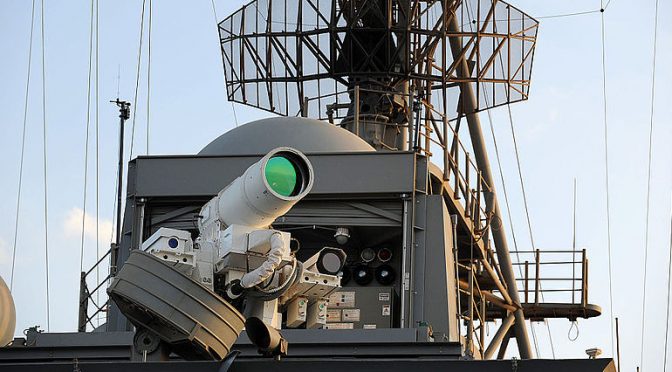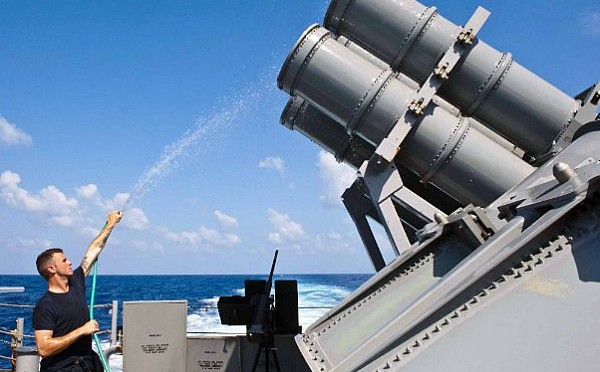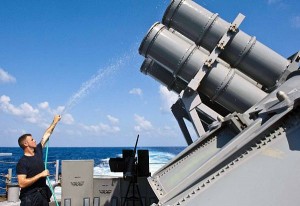By Tim McGeehan and Douglas Wahl
Attrition
On December 7, 1941, shortly after the attack on Pearl Harbor, Chief of Naval Operations (CNO) Admiral Stark issued the directive “Execute Against Japan Unrestricted Air and Submarine Warfare.” This was the opening phase of America’s strategy to engage Japan in a long war of attrition. Japan, on the other hand, had hoped for a short and limited war that would be concluded before America could fully mobilize. The American population, economy, and industrial base were asymmetric advantages that the Japanese could not hope to counter in the long run. Simply put, we could replace combat losses of people and platforms while they could not.
Now, our potential adversaries favor Anti-Access/Area Denial (A2/AD) strategies that seek to keep our military at arm’s length and limit our power projection. Underlying this strategy is the familiar concept of attrition. To fight the “away game” our military will have to successfully penetrate multi-layered defenses extending well offshore and survive continuous engagement to carry the fight to our adversaries’ homeland. The recent proliferation of technology including long-range sensors, anti-ship ballistic and cruise missiles, and electronic warfare capabilities that aim to disrupt our command, control, communications, computers, intelligence, surveillance, and reconnaissance (C4ISR) are making their A2/AD strategies increasingly viable.
While our Navy is accustomed to fighting the “away game,” attrition is a strategy we can ill afford today. Unlike World War II, with the 24-hour news cycle and the speed of information via the Internet, the United States can no longer politically accept a war with heavy losses of personnel or platforms. We no longer possess the production facilities to rapidly replace extensive combat losses of materiel that we could in World War II. Though we are the world’s largest Navy, our number of capital ships is limited and future investments to numerically grow the Fleet must be weighed against the need for development of advanced capabilities. If we are going to successfully engage adversaries relying on A2/AD strategies, our Navy needs bold and innovative solutions that can successfully counter their attrition focus.
The Salvo Competition
Sun Tzu reminds us that it is most important to attack the enemy’s strategy and we need to do just that. A key aspect our adversaries rely on to achieve the desired attrition is winning the “salvo competition.” As we approach their coasts, our adversaries believe they can overwhelm our ships based on the sheer number of long-range anti-ship and ballistic missiles they can deliver versus the more limited number we can defend against based on our current magazine depth. Our surface ships have advanced “hard kill” point defenses such as the Standard Missile (SM-2), Close-in-Weapon System (CIWS), Evolved Sea Sparrow Missile (ESSM), Rolling Airframe Missile (RAM), and SeaRAM. No matter how effective these systems are, they may run out of missiles and ordnance long before our adversary does, opening the door to unsustainable losses. To help increase survivability, the Navy is upgrading our softkill systems such as AN/SLQ-32 as part of the Surface Electronic Warfare Improvement Program (SEWIP).1 However, as the sophistication of adversary weapons continuously increases, the continued ability of these systems to adapt is uncertain.
We need to turn the tables on attrition by changing the asymmetric balance of the salvo competition between A2/AD assets and power-projecting naval forces. However, we cannot continue to rely on incremental advances by linearly extrapolating our capabilities; instead we must take advantage of highly non-linear opportunities provided by leveraging emerging technology. In 2015, former CNO Admiral Greenert challenged the Science and Technology community to “get us off gunpowder.”2 The Navy needs to rise to this challenge and accelerate the investment, development, and fielding of directed energy weapons across the Fleet.3
Technologies and Advantages
Directed energy weapons offer many advantages to help us defeat an A2/AD strategy, increasing lethality and survivability while decreasing cost and logistical burdens. With a range exceeding 100 nautical miles, the Electromagnetic Rail Gun (EMRG) can execute multiple missions at significantly greater range than today’s “conventional” gun systems, including anti-surface, naval surface fire support (NSFS), air defense, and ballistic missile defense.4 Additionally, although the existing Tomahawk Land Attack Missile (TLAM) and strike aircraft have strike ranges greater than the EMRG, many targets will be well within the EMRG’s range which would allow us to husband those more limited and expensive strike resources. Additionally, the EMRG round’s small size, high speed, and kinetic energy make it extremely hard to intercept or defend against. Technical progress continues, working toward the future fielding of EMRG at sea.5
The solid-state 30 kilowatt (kW) Laser Weapons System (LaWS), on the other hand, was already operationally deployed on the USS Ponce in the U.S. Central Command AOR in 2014.6 It demonstrated the ability to disable an Unmanned Aerial Vehicle (UAV), disable a small boat engine, and detonate ammunition.7 Follow-on Navy efforts continue: at the 2017 Surface Navy Association (SNA) symposium, Rear Admiral Boxall, Director of Surface Warfare, announced plans to test fire a 150 kW weapon from a ship in the near future, and at the 2018 SNA symposium it was announced that USS Portland will soon host a new laser system in another technology demonstration.8 Likewise, efforts are underway with the Navy’s High Energy Laser with Integrated Optical-Dazzler and Surveillance (HELIOS) project (60kW with potential growth to 150kW) as well as the Defense Advanced Research Projects Agency’s (DARPA) High Energy Liquid Laser Area Defense System (HELLADS) project (in the 150 kW range), which may present future opportunities for demonstration at sea.9
LaWS test (U.S. Navy video)
High-powered microwave weapons are another category of directed energy weapons that could be soon employed at sea. High power microwaves can be used for electronic attack to destroy or disrupt specific components of adversary communication and sensor systems or even be applied to counter- improvised explosive device (IED) operations.10 In 2012, the Air Force Research Lab successfully demonstrated the Counter-electronics High-power microwave Advanced Missile Project (CHAMP) that developed an air-launched cruise missile outfitted with a high-power microwave payload.11
Collectively, these directed energy weapons will allow us to counter A2/AD by winning the salvo competition. The small size of EMRG rounds also translates into a vastly expanded magazine when compared to the limited number of Vertical Launch System (VLS) cells of our current surface combatants. LaWS and high-powered microwave weapons go even further, offering a virtually bottomless magazine, limited only by power generation. These new weapons also shift the cost curve in our favor. For short-range strike missions, a TLAM costs between $1.1 and 1.4 million12 per missile and an F/A-18E/F Super Hornet flying over the beach costs $80+ million,13 not including the cost to recruit, train, and maintain the pilot. On the defensive side, existing Naval surface-to-air missiles vary in cost from about $900,000 for a RAM to over $20 million for an SM-3 Block IIA for ballistic missile defense.14 In contrast, an EMRG round costs $25,000 and LaWS costs $1 per shot, making them extremely cost effective alternatives.15 The combination of decreased physical size and lower cost will also enable our surface Fleet to counter the missile, UAV, and small boat swarms of A2/AD without being overwhelmed.
Another aspect of countering the A2/AD attrition calculus is increasing survivability. In today’s environment almost any hit to a ship is a mission kill, which places a premium on not getting hit in the first place. The increased range of EMRG allows for increased standoff distance during littoral strike or naval surface fire support missions in support of forces ashore. LaWS could engage incoming missiles at a greater range than existing CIWS systems, which have such short range that shrapnel from a destroyed anti-ship missile could still have enough kinetic energy to damage a ship and provide a mission kill. The EMRG could even be armed with a “point defense” projectile that deploys submunitions of flechette, airburst, or grapeshot against incoming threats. The increased power systems required for EMRG could also enable more powerful electronic warfare capabilities that in turn could defeat incoming missiles. However, the shift to directed energy weapons will have the greatest boost to surface ship survivability because they lack what is traditionally the most vulnerable part of the ship – the explosives in its magazine. Storing explosive rounds and propellants onboard also necessitates additional damage control systems and armor, which could be reduced, allowing tradeoffs in the constant naval architecture balance of size and weight.
Directed energy weapons also have a second order benefit in countering A2/AD by decreasing our logistics burden. Our surface Fleet is constrained and restrained by logistics – specifically our supply ships that are an often overlooked critical vulnerability. While our forward deployed Fleet relies almost exclusively on them for the resupply of food, parts, and fuel, there are very few of these ships in the inventory. On top of their limited availability, logistic ships have limited defenses and in a hostile environment will require an armed escort, which will in turn detract from forces available for the fight. Moreover, they have to cover long distances to and from logistics hubs. With directed energy weapons, our Fleet could have deeper magazines and still trade some space to carry more fuel, parts, and stores. This would reduce the Fleet’s dependence on combat replenishment, both limiting the exposure of and the burden on these scarce, vulnerable assets. Furthermore, replenishment of EMRG magazines could occur at sea and on station. Reloading of VLS cells, on the other hand, currently must be done pier-side in port, in a protected anchorage, or in optimal conditions at sea.16 Depending on the availability of these areas and their proximity to the front, combatants may incur a significant loss of time on station while transiting to and from them.
The logistical benefits of directed energy weapons may extend beyond the A2/AD environment. In future conflicts we may have to begin the fight closer to home – against enemy submarines and forward deployed long-range aircraft. Fighting our way across the ocean will entail long transits before we even get in position to fight the “away game” in our adversary’s waters. Reducing the frequency of required resupply operations will reduce the exposure and vulnerability of our limited logistics force.
Questions, Barriers, and Integration
There are additional force structure, strategic laydown, and force employment questions to consider with the adoption of directed energy weapons. How will the integration of weapons like EMRG and LaWS and their assumption of air defense and short-range strike missions impact the future requirements and composition of the Air Wing and the Strike Group? In the future, with drastically deeper magazines, one ship will have the capacity of several existing ships. Since the number of ships on station is often related to the aggregate number and type of missiles in their VLS cells, will there be a decreased requirement for the number of ships and submarines to be in theater or on station? It is true that a ship can only be in one place at a time, but with the longer range each EMRG ship could impact a greater area.
EMRG test (U.S. Navy video via AiirSource)
Could the aircraft carrier reach a point where it won’t require a “shotgun” and strike group escorts can be detached for independent operations? Could an EMRG equipped DDG-1000 holding the bulk of the theater’s projectile and missile magazines act as an “arsenal ship” that challenges the aircraft carrier as the new premier capital ship? How will directed energy weapons impact manpower? Will the technicians who maintain and operate directed energy systems and their power supplies be lured away by a private industry focusing on the next generation of battery and energy storage technology – similar to the way the defense contractor UAV market has recruited UAV pilots out of the Air Force? Will EMRG find uses beyond weapons delivery? The National Aeronautics and Space Administration (NASA) has considered building a massive EMRG to launch objects into space.17 Could a Navy EMRG someday be used to inject nanosatellites into low-earth orbit and rapidly reconstitute or augment a constellation in response to adversary attacks on our space-based systems?
With a reduced footprint and fewer electrical requirements, LaWS (or its successor) can be deployed on a wider variety of platforms. However, USS Ponce’s laser was powered by a diesel engine independent of the ship’s power system. Likewise, during a test onboard USS Dewey (DDG-105), LaWS was powered by an independent, commercial generator system and not integrated into the ship’s power grid.18 Fielding EMRG on a vessel will require it to be able to accommodate the equipment for energy generation and storage, pulse forming, and cooling. Even with expected achievements in increased battery storage and power production, the EMRG will likely have to be installed on larger platforms such as the DDG-1000 to be feasible. But given there will be just three Zumwalt destroyers, the Navy will only be able to reap the benefits of directed energy with the next generation of surface combatants (absent a technological revolution that would enable it to be fielded on today’s combatants) and therefore directed energy must play a key role in setting the requirements for these ships. The Navy requires additional enablers to realize and take advantage of directed energy weapons and harness the technological advances in battery technology from firms like Tesla as they move from powering cars to powering homes and building smart electrical grids.
There are risks associated with fielding directed energy weapons. As electronics-intensive systems, will they require significant modification of their components to shield against electromagnetic pulse (EMP) and microwave weapons? Likewise, the environmental impact of environments featuring extensive dust, sand, precipitation, and clouds for weapons like LaWS are unclear. Will LaWS be a ‘fair weather’ weapon and require redundant foul-weather backup capability such as the CIWS? Finally, there are damage control concerns with the extensive battery systems. Can a ship’s crew repair battle damage at sea, swap out modular battery components, or fight hurt?
The issues extend beyond the technical barriers. Alfred Thayer Mahan wrote “an improvement of weapons is due to the energy of one or two men, while changes in tactics have to overcome the inertia of a conservative class.”19 Experimentation like the demonstrations of LaWS on the USS Ponce are important, but integrating new capabilities into major exercises and wargames will be required to prove new capabilities, develop tactics, techniques, and procedures, and overcome skepticism from those who are heavily invested in outdated systems and concepts.
Conclusion
The U.S. Navy must continue to leverage emerging technology to counter adversary A2/AD strategies. Directed energy weapons offer a means of denying attrition by winning the salvo competition and increasing survivability. We are on the verge of realizing the full potential of these game-changing technologies. Fielding them across the Fleet will have implications that span most aspects of the Navy, from force structure to strategic laydown, and from missions to personnel. Any change in weapons or tactics involves risk but we must not shy away from it if we are to remain ahead. In the words of President Eisenhower from his First Inaugural Address “We must be ready to dare all for our country. For history does not long entrust the care of freedom to the weak or the timid.”20
Tim McGeehan is a U.S. Navy Officer currently serving in Washington.
Douglas T. Wahl is a Systems Engineer at Science Applications International Corporation.
The ideas presented are those of the authors alone and do not reflect the views of the Department of the Navy, Department of Defense, or Science Applications International Corporation.
This article is an adaptation from an essay that was awarded Second Place in the 2016 U.S. Naval Institute’s 2016 Emerging & Disruptive Technologies Essay Contest which was sponsored by Leidos.
References
[1] http://www.navy.mil/navydata/fact_display.asp?cid=2100&tid=475&ct=2
[2] David Smalley, CNO: Here’s What We Need for the Future Force, Navy News Service, February 5, 2015, http://www.navy.mil/submit/display.asp?story_id=85464
[3] Note that for the purposes of this report “directed energy weapons” includes electromagnetic railgun
[4] Office of Naval Research Fact Sheet, Electromagnetic Railgun, http://www.onr.navy.mil/Media-Center/Fact-Sheets/Electromagnetic-Railgun.aspx
[5] Sydney Freedberg, Navy Railgun Ramps up in Test Shots, Breaking Defense, May 19, 2017, https://breakingdefense.com/2017/05/navy-railgun-ramps-up-in-test-shots/
[6] David Smalley, Historic Leap: Navy Shipboard Laser Operates in the Arabian Gulf, Navy News, December 10, 2014, http://www.navy.mil/submit/display.asp?story_id=84805
[7] Sam LaGrone, U.S. Navy Allowed to Use Persian Gulf Laser for Defense, USNI, December 11, 2014, http://news.usni.org/2014/12/10/u-s-navy-allowed-use-persian-gulf-laser-defense
[8] Maike Fabey and Kris Osborn, The U.S. Navy is Moving at Warp Speed to Develop Super Lasers, The National Interest, January 24, 2017, http://nationalinterest.org/blog/the-buzz/the-us-navy-moving-warp-speed-develop-super-lasers-19165 ; Megan Eckstein, LPD Portland Will Host ONR Laser Weapon Demonstrator, Serve as RIMPAC 2018 Flagship, USNI News, January 10, 2018, https://news.usni.org/2018/01/10/lpd-portland-selected-host-onr-laser-weapon-demonstrator-serve-rimpac-2018-flagship
[9] John Wallace, General Atomics to build a second 150 kW HELLADS military laser, this one for the U.S. Navy, January 29, 2013, Laser Focus World, http://www.laserfocusworld.com/articles/2013/01/general-atomics-to-build-a-second-150-kw-hellads-military-laser-.html ; DARPA, Notice of Intent to Award Sole Source Contract For High Energy Liquid Laser Area Defense System (HELLADS) Laser, FebBizOps, January 17, 2013, https://www.fbo.gov/index?s=opportunity&mode=form&id=f05c2a61208344f5e3586e17b60127d3&tab=core&_cview=0 ; DARPA Press Release, HELLADS Laser Achieves Acceptance For Field Testing, May 21, 2015, http://www.darpa.mil/news-events/2015-05-21-2 ; Ronald O’Rourke, Navy Lasers, Railgun, and Hypervelocity Projectile: Background and Issues for Congress, December 8, 2017, Congressional Research Service, https://fas.org/sgp/crs/weapons/R44175.pdf
[10] Richard Carlin, DoD Energy and Power Roadmap (brief to Energy & Power Community of Interest), March 25, 2015, http://www.defenseinnovationmarketplace.mil/resources/EP_COI_NDIA_BriefingDistA20150325.pdf
[11] CSBA, Directed Energy Summit-Summary Report, July 28, 2015, 2015 Directed Energy Summit – Summary Report – Center … ; Boeing Press Release, Boeing CHAMP Missile Completes 1st Flight Test, September 22, 2011, http://boeing.mediaroom.com/2011-09-22-Boeing-CHAMP-Missile-Completes-1st-Flight-Test ; Boeing, CHAMP – Lights Out, October 22, 2012, http://www.boeing.com/features/2012/10/bds-champ-10-22-12.page ; George I. Seffers, CHAMP Prepares For Future Fights, February 1, 2016, http://www.afcea.org/content/?q=Article-champ-prepares-future-fights; Bud Cordova, AFRL division chief presents abilities of high-powered microwave weapons, September 16, 2016, http://www.wpafb.af.mil/News/Article-Display/Article/948603/afrl-division-chief-presents-abilities-of-high-powered-microwave-weapons
[12] Federation of American Scientists, BGM-109 Tomahawk, http://fas.org/man/dod-101/sys/smart/bgm-109.htm
[13] F/A-18E/F Super Hornet, Aeroweb, http://www.bga-aeroweb.com/Defense/F-18-Super-Hornet.html
[14] Ron O’Rourke, Navy Lasers, Railgun, and Hypervelocity Projectile: Background and Issues for Congress, Congressional Research Service, November 6, 2015, https://www.fas.org/sgp/crs/weapons/R44175.pdf, p. 3
[15] Ron O’Rourke, Navy Lasers, Railgun, and Hypervelocity Projectile: Background and Issues for Congress, Congressional Research Service, November 6, 2015, https://www.fas.org/sgp/crs/weapons/R44175.pdf, p. 4
[16] Hunter Stires, CNO Announces the Return of Vertical Launch System At-Sea Reloading, The National Interest, July 5, 2017, http://nationalinterest.org/feature/exclusive-cno-announces-the-return-vertical-launch-system-21425
[17] Rena Marie Pacella, NASA Engineers Propose Combining a Rail Gun and a Scramjet to Fire Spacecraft Into Orbit, Popular Science, December 17, 2010, http://www.popsci.com/technology/article/2010-11/nasa-engineers-propose-combining-rail-gun-and-scramjet-fire-spacecraft-orbit
[18] Spencer Ackerman, Watch the Navy’s New Ship-Mounted Laser Cannon Kill a Drone, April 8, 2013, http://www.wired.com/2013/04/laser-warfare-system/
[19] Alfred T. Mahan, The Influence of Sea Power Upon History 1660-1783, page 7
[20] Dwight Eisenhower, Inaugural Address, January 20, 1953, PBS: American Experience, http://www.pbs.org/wgbh/americanexperience/features/primary-resources/eisenhower-inaugural53/
Featured Image: The U.S. Navy Afloat Forward Staging Base (Interim) USS Ponce (AFSB(I)-15) conducts an operational demonstration of the Office of Naval Research (ONR)-sponsored Laser Weapon System (LaWS) while deployed to the Arabian Gulf. (U.S. Navy photo by John F. Williams)







